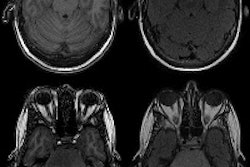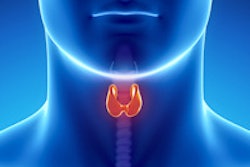It can be hard to determine how to manage thyroid nodules detected incidentally on imaging exams. However, an American College of Radiology (ACR) committee hopes its new white paper will help those decisions be more consistent, lead to lower costs, and avoid unnecessary patient anxiety and potential morbidity.
In an article published online November 1 in the Journal of the American College of Radiology, the ACR Incidental Thyroid Findings Committee provided its consensus recommendations for a practical approach on how to manage incidental thyroid nodules detected on ultrasound, CT, MRI, and nuclear medicine studies.
A very common finding on imaging studies, incidental thyroid nodules are mostly benign. However, the workup of these nodules has led to increased costs from additional procedures and, in some cases, increased risk to the patient.
Furthermore, small incidental thyroid malignancies typically have indolent behavior, according to lead author Dr. Jenny Hoang of Duke University Medical Center.
"Given these three facts, many incidental thyroid nodules that radiologists detect should not be reported in the impression of the radiology report and should not receive workup," she told AuntMinnie.com.
Currently, there isn't much in the way of guidance from professional organizations on managing incidental thyroid nodules. There is also significant variability in how radiologists report these nodules, according to the authors.
As a result, the Incidental Thyroid Findings Committee was formed under the auspices of the ACR in 2013. The committee, which consisted of both academic and private-practice radiologists with subspecialties in sonography, abdominal imaging, neuroradiology, and chest imaging, aimed to produce a white paper that would provide a practical approach to managing incidental thyroid nodules seen on CT, MRI, nuclear medicine, and ultrasound studies. The final paper represents the committee's literature review and their practical experience, Hoang said.
The white paper provides three sets of recommendations -- including flow charts -- for incidental thyroid nodules found on CT/MRI, nuclear medicine, and extrathyroidal ultrasound, respectively.
For incidental thyroid nodules found on CT, MRI, and extrathyroidal ultrasound, the recommended workup is based on the presence of suspicious imaging findings, patient life expectancy, patient age, and nodule size.
"In patients with normal life expectancy and without suspicious imaging findings, the committee recommends workup with dedicated thyroid ultrasound for nodules ≥ 1 cm in patients under 35 years of age, and an increased size cutoff of ≥ 1.5 cm in patients 35 years or older," Hoang said.
Recommendations are different for those found on nuclear medicine studies; size and age are not part of the criteria.
"On [F-18 FDG PET], focal metabolic activity in the thyroid is a highly suspicious finding and so the committee recommends both dedicated thyroid ultrasound and [fine-needle aspiration biopsy] of the PET-avid lesion if the patient has normal life expectancy," Hoang said. "For other nuclear medicine studies, the committee recommends dedicated thyroid ultrasound for focal metabolic activity if the patient has normal life expectancy."
There are no plans for the recommendations to become part of the ACR Practice Parameters and Technical Standards guidelines or the ACR Appropriateness Criteria, she noted.
"We will, however, reassess our recommendations periodically with feedback from radiologists and in light of future research on this topic," Hoang said.




















